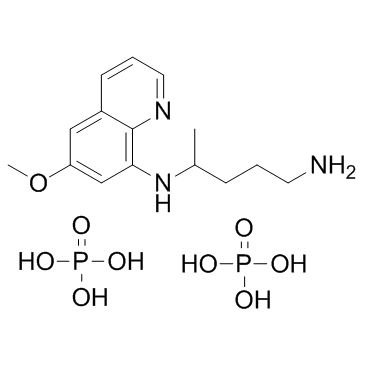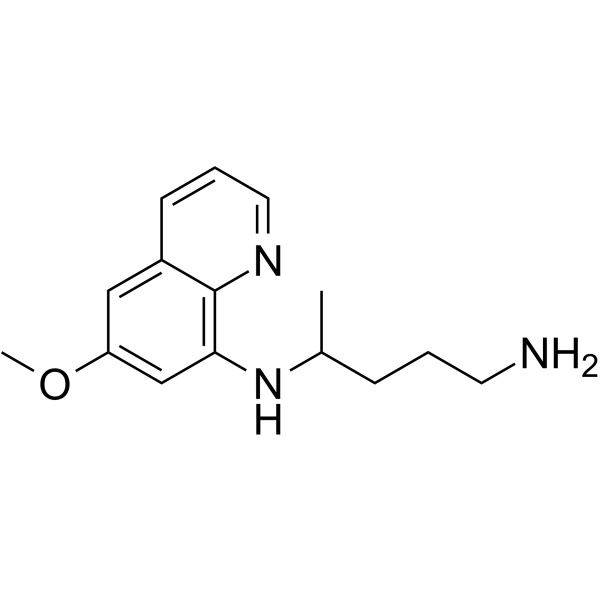primaquine phosphate

primaquine phosphate structure
|
Common Name | primaquine phosphate | ||
|---|---|---|---|---|
| CAS Number | 63-45-6 | Molecular Weight | 455.337 | |
| Density | N/A | Boiling Point | 451.1ºC at 760 mmHg | |
| Molecular Formula | C15H27N3O9P2 | Melting Point | 205-206 °C (dec.)(lit.) | |
| MSDS | Chinese USA | Flash Point | 226.6ºC | |
| Symbol |

GHS06 |
Signal Word | Danger | |
Use of primaquine phosphatePrimaquine is the only generally available anti-malarial that prevents relapse in vivax and ovale malaria, and the only potent gametocytocide in falciparum malaria. |
| Name | Primaquine bisphosphate |
|---|---|
| Synonym | More Synonyms |
| Description | Primaquine is the only generally available anti-malarial that prevents relapse in vivax and ovale malaria, and the only potent gametocytocide in falciparum malaria. |
|---|---|
| Related Catalog | |
| References |
[1]. Ashley EA, et al. Primaquine: the risks and the benefits. Malar J. 2014 Nov 3;13:418. |
| Boiling Point | 451.1ºC at 760 mmHg |
|---|---|
| Melting Point | 205-206 °C (dec.)(lit.) |
| Molecular Formula | C15H27N3O9P2 |
| Molecular Weight | 455.337 |
| Flash Point | 226.6ºC |
| Exact Mass | 455.122253 |
| PSA | 235.31000 |
| LogP | 1.69880 |
| Stability | Stable. Incompatible with strong oxidizing agents. |
| Water Solubility | moderately soluble |
Synonym:8-(4-Amino-1-methylbutylamino)-6-methoxyquinoline diphosphat Section 2 - COMPOSITION, INFORMATION ON INGREDIENTS
Risk Phrases: 25 Section 3 - HAZARDS IDENTIFICATION EMERGENCY OVERVIEW
Toxic if swallowed. Potential Health Effects The toxicological properties of this material have not been investigated. Use appropriate procedures to prevent opportunities for direct contact with the skin or eyes and to prevent inhalation. Section 4 - FIRST AID MEASURES Eyes: Immediately flush eyes with plenty of water for at least 15 minutes, occasionally lifting the upper and lower eyelids. Skin: Flush skin with plenty of water for at least 15 minutes while removing contaminated clothing and shoes. Ingestion: Do NOT induce vomiting. If conscious and alert, rinse mouth and drink 2-4 cupfuls of milk or water. Inhalation: Remove from exposure and move to fresh air immediately. Notes to Physician: Section 5 - FIRE FIGHTING MEASURES General Information: As in any fire, wear a self-contained breathing apparatus in pressure-demand, MSHA/NIOSH (approved or equivalent), and full protective gear. Extinguishing Media: In case of fire, use water, dry chemical, chemical foam, or alcohol-resistant foam. Section 6 - ACCIDENTAL RELEASE MEASURES General Information: Use proper personal protective equipment as indicated in Section 8. Spills/Leaks: Sweep up, then place into a suitable container for disposal. Section 7 - HANDLING and STORAGE Handling: Not available. Storage: Not available. Section 8 - EXPOSURE CONTROLS, PERSONAL PROTECTION Engineering Controls: Use adequate general or local exhaust ventilation to keep airborne concentrations below the permissible exposure limits. Exposure Limits CAS# 63-45-6: Personal Protective Equipment Eyes: Wear safety glasses and chemical goggles if splashing is possible. Skin: Wear appropriate protective gloves and clothing to prevent skin exposure. Clothing: Wear appropriate protective clothing to minimize contact with skin. Respirators: Wear a NIOSH/MSHA or European Standard EN 149 approved full-facepiece airline respirator in the positive pressure mode with emergency escape provisions. Section 9 - PHYSICAL AND CHEMICAL PROPERTIES Physical State: Powder Color: orange Odor: None reported. pH: Not available. Vapor Pressure: Not available. Viscosity: Not available. Boiling Point: Not available. Freezing/Melting Point: 205.00 - 206.00 deg C Autoignition Temperature: Not available. Flash Point: Not available. Explosion Limits, lower: Not available. Explosion Limits, upper: Not available. Decomposition Temperature: Solubility in water: Specific Gravity/Density: Molecular Formula: C15H21N3O.2H3PO4 Molecular Weight: 455.34 Section 10 - STABILITY AND REACTIVITY Chemical Stability: Stable under normal temperatures and pressures. Conditions to Avoid: Not available. Incompatibilities with Other Materials: Strong oxidizing agents. Hazardous Decomposition Products: Nitrogen oxides, phosphine, carbon monoxide, carbon dioxide, nitrogen. Hazardous Polymerization: Has not been reported. Section 11 - TOXICOLOGICAL INFORMATION RTECS#: CAS# 63-45-6: VA9660000 LD50/LC50: CAS# 63-45-6: Oral, mouse: LD50 = 68 mg/kg; Oral, rat: LD50 = 177 mg/kg. Carcinogenicity: Primaquine diphosphate - Not listed by ACGIH, IARC, or NTP. Other: See actual entry in RTECS for complete information. Section 12 - ECOLOGICAL INFORMATION Section 13 - DISPOSAL CONSIDERATIONS Dispose of in a manner consistent with federal, state, and local regulations. Section 14 - TRANSPORT INFORMATION IATA Shipping Name: TOXIC SOLID, ORGANIC, N.O.S.* Hazard Class: 6.1 UN Number: 2811 Packing Group: III IMO Shipping Name: TOXIC SOLID, ORGANIC, N.O.S. Hazard Class: 6.1 UN Number: 2811 Packing Group: III RID/ADR Shipping Name: TOXIC SOLID, ORGANIC, N.O.S. Hazard Class: 6.1 UN Number: 2811 Packing group: III Section 15 - REGULATORY INFORMATION European/International Regulations European Labeling in Accordance with EC Directives Hazard Symbols: T Risk Phrases: R 25 Toxic if swallowed. Safety Phrases: S 22 Do not breathe dust. WGK (Water Danger/Protection) CAS# 63-45-6: No information available. Canada None of the chemicals in this product are listed on the DSL/NDSL list. CAS# 63-45-6 is not listed on Canada's Ingredient Disclosure List. US FEDERAL TSCA CAS# 63-45-6 is not listed on the TSCA inventory. It is for research and development use only. SECTION 16 - ADDITIONAL INFORMATION N/A |
CHEMICAL IDENTIFICATION
HEALTH HAZARD DATAACUTE TOXICITY DATA
MUTATION DATA
|
| Symbol |

GHS06 |
|---|---|
| Signal Word | Danger |
| Hazard Statements | H301 |
| Precautionary Statements | Missing Phrase - N15.00950417 |
| Personal Protective Equipment | Eyeshields;Faceshields;Gloves;type P2 (EN 143) respirator cartridges |
| Hazard Codes | T:Toxic |
| Risk Phrases | R25 |
| Safety Phrases | S45 |
| RIDADR | UN 2811 6.1/PG 3 |
| WGK Germany | 3 |
| RTECS | VA9660000 |
| Packaging Group | III |
| Hazard Class | 6.1(b) |
| HS Code | 2933499090 |
| Precursor 0 | |
|---|---|
| DownStream 2 | |
| HS Code | 2933499090 |
|---|---|
| Summary | 2933499090. other compounds containing in the structure a quinoline or isoquinoline ring-system (whether or not hydrogenated), not further fused. VAT:17.0%. Tax rebate rate:13.0%. . MFN tariff:6.5%. General tariff:20.0% |
|
Optimization of primaquine diphosphate tablet formulation for controlled drug release using the mixture experimental design.
Pharm. Dev. Technol. 18(5) , 1247-54, (2013) A tablet formulation based on hydrophilic matrix with a controlled drug release was developed, and the effect of polymer concentrations on the release of primaquine diphosphate was evaluated. To achie... |
|
|
Development of simplified HPLC methods for the detection of counterfeit antimalarials in resource-restraint environments.
J. Pharm. Biomed. Anal. 98 , 434-45, (2014) Regular quality control and post-marketing surveillance of pharmaceuticals has been a critical challenge for countries of the developing world ever since. Counterfeit and substandard medicines are wid... |
|
|
Validation of a method for the simultaneous quantification of chloroquine, desethylchloroquine and primaquine in plasma by HPLC-DAD
J. Pharm. Biomed. Anal. 95 , 200-6, (2014) • Chloroquine, desethyl chloroquine and primaquine level were quantified simultaneously by HPLC-DAD. • The method validation parameters were adequate according international standards. • Sample prepar... |
| 1,4-pentanediamine, N4-(6-methoxy-8-quinolinyl)-, phosphate (1:2) |
| N4-(6-methoxyquinolin-8-yl)pentane-1,4-diamine phosphate (1:2) |
| N-(6-Methoxy-8-quinolinyl)-1,4-pentanediamine phosphate (1:2) |
| EINECS 200-560-8 |
| Primaquine phosphate |
| N-(6-Methoxyquinolin-8-yl)pentane-1,4-diamine phosphate (1:2) |
| Primaquine diphosphate |
| 4-N-(6-methoxyquinolin-8-yl)pentane-1,4-diamine,phosphoric acid |
| Primaquine diphosphate salt |
| 1,4-Pentanediamine, N-(6-methoxy-8-quinolinyl)-, phosphate (1:2) |
| primaquine bis(phosphate) |
| MFCD00013166 |
| Primaquine (Diphosphate) |
 CAS#:90-34-6
CAS#:90-34-6![2,2,2-trifluoro-N-[4-[(6-methoxyquinolin-8-yl)amino]pentyl]acetamide structure](https://image.chemsrc.com/caspic/274/88755-75-3.png) CAS#:88755-75-3
CAS#:88755-75-3
